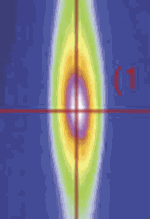A new insulating material with the lowest thermal conductivity ever measured for a fully dense solid has been created at the University of Oregon (UO) and tested at the XOR/UNI 33-BM beamline at the U.S. Department of Energy’s Advanced Photon Source (APS) at Argonne. The research was carried out by collaborators from the UO, the University of Illinois at Urbana-Champaign, the Rensselaer Polytechnic Institute, and Argonne. While far from having immediate application, the principles involved, once understood, could lead to improved insulation for a wide variety of uses, the scientists say.
In the paper published in the journal Science, the scientists describe how they used a novel approach to synthesize various thicknesses of tungsten diselenide. This effort resulted in a random stacking of tungsten-diselenide planes (WSe2 ), possibly leading to a localization of lattice vibrations.
The resulting synthesized material, they report, resulted in thermal conductivity – the rate at which heat flows through a material – 30 times smaller than that for single-crystal WSe2 and a factor six smaller that the minimum level predicted by theoretical computations for the cross-plane thin films used in the experiments.
Surprisingly, creating a fully disordered structure by bombarding the films with ions to destroy the order in the two-dimensional planes actually increases thermal conductivity, said David C. Johnson, a professor of chemistry at the University of Oregon and member of the UO Materials Science Institute.
"The reason for the extraordinarily low thermal conductivity that we've now achieved is an unusual structure which is crystalline in two directions but has a subtle rotational disorder in the direction of low-heat conduction," Johnson said.
The material prepared in Johnson's lab "is the closest thing that anyone has found to making a dense solid into a perfect thermal insulator," said co-author and corresponding investigator David G. Cahill, a professor of materials science and engineering at the University of Illinois at Urbana-Champaign. "This material would not be practical for insulating a refrigerator, the wall of a house or parts inside a turbine engine, but the new physical properties displayed by this material might some day point the way toward methods of creating more effective practical insulations."
The approach is a new alternative to one described by Cahill and others in separate journal articles in the last two years, in which researchers reduced minimum thermal conductivity by manipulating thin films of metals and oxides by adjusting interfaces of the materials by only a few nanometers.
"Thermal conductivity is an important property in both conserving energy and in converting between forms of energy," Johnson said. "Obtaining low thermal conductivity in a thermoelectric material, which converts temperature gradients into electrical energy, increases efficiency."
The properties of Johnson's material were measured in Cahill's Illinois laboratory. The structure was analyzed at the APS. Computational simulations and molecular modeling of the layered crystals was carried out by researchers at Rensselaer Polytechnic Institute (RPI) in Troy, N.Y.
Co-authors Pawel Keblinski and Arun Bodapati, both at RRI, said that the observed ultra-low thermal conductivity is not limited to tungsten diselenide and likely could be applied to a wide variety of disordered layered crystals.
Other co-authors were Catalin Chiritescu, a student in Cahill's lab at the University of Illinois; Ngoc Nguyen, a doctoral student in Johnson's UO lab; and Paul Zschack of Argonne's Advanced Photon Source.
The Office of Naval Research and the U.S. Department of Energy provided funding for various components of the project. Use of the Advanced Photon Source was supported by the U. S. Department of Energy, Office of Science, Office of Basic Energy Sciences, under Contract No. DE-AC02-06CH11357.
Contacts: Jim Barlow, director of science and research communications, University of Oregon, 541-346-3481.
Sources: David C. Johnson, professor of chemistry, UO Materials Science Institute, 541-346-4612; David G. Cahill, Willett Professor of Engineering, professor of materials science and engineering, University of Illinois, 217-333-6753
Argonne is a U.S. Department of Energy laboratory managed by UChicago Argonne, LLC

